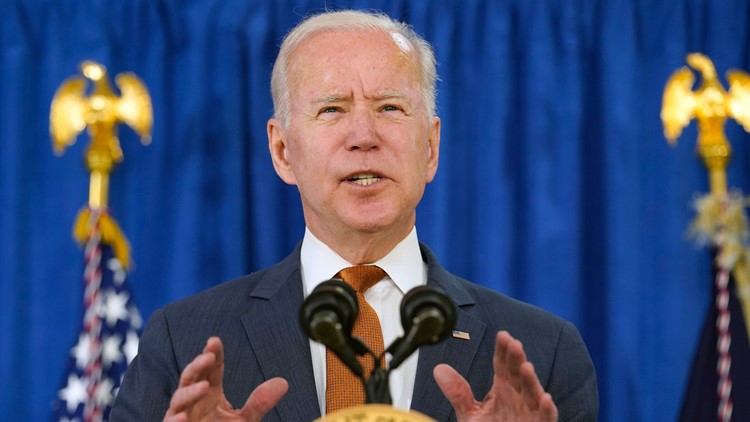The COVID-19 pandemic has had a crippling effect on the U.S. economy as shutdowns led to millions of people losing their jobs in 2020. But with more people getting vaccinated and cases on the decline, fewer restrictions are being placed on businesses.
During a speech in Delaware on June 4, President Joe Biden responded to the latest jobs report by saying, “we have now created over 2 million jobs in total since I took office — more jobs than have ever been created in the first four months of any presidency in modern history.”
THE QUESTION
Has the Biden administration overseen the most job creation in the first four months of any administration in modern American history?
THE SOURCES
- U.S. Bureau of Labor Statistics (BLS)
- Tim Duy, professor of practice in Department of Economics at University of Oregon
THE ANSWER
Yes, the Biden administration has overseen the largest increase in total number of jobs of any administration’s first four months dating back to 1939, when monthly data was first tracked. But the claim also needs context about the circumstances under which Biden took office.
WHAT WE FOUND
The U.S. Bureau of Labor Statistics (BLS) has data showing job growth and decline by month dating back to 1939.
According to BLS data, 2.1 million more people were employed in May 2021 than in January 2021, when Biden took office. No other administration in its first four months, dating back to 1939, has seen more people gain employment. But there are more people in the U.S. now than there were at the start of other presidential administrations.
There are also several factors to consider when evaluating job growth at the beginning of Biden’s presidency, most notably the reopening of the economy following shutdowns in response to the pandemic, according to Tim Duy, professor of practice in the Department of Economics at the University of Oregon.
“We were fairly certain that when the economy was able to reopen, particularly when leisure and hospitality activity was able to restart to something much more consistent with what we saw pre-pandemic, that we would see a surge of job growth,” Duy explained. “And that's exactly what we've seen.”
The COVID-19 pandemic led to job losses not seen since BLS began publishing monthly data in 1939 for total nonfarm employment. According to BLS data, about 152.5 million people were employed in the U.S. in February 2020. By April 2020, just 130.1 million people were employed, a loss of more than 22 million jobs as the unemployment rate reached a pandemic high of 14.8%.
Six months later, by October 2020, more than half of the job losses incurred at the start of the pandemic had been regained as about 142.5 million people were employed in the U.S., according to BLS data. But there was a plateau in job growth during the final three months of then-President Donald Trump’s term. By January 2021, there were about 142.7 million people employed.
Duy said a rise in COVID-19 cases and the reinstitution of stricter lockdown measures in the winter factored into the slower job growth.
“In this particular dynamic, again, you're stuck with the pandemic was here, we dealt with it, it came back or resurged in the fall and winter, and so job growth slowed,” he said. “As we move past it, job growth is going to accelerate.”
During the first four months of Biden’s presidency, employment increased by 536,000 people in February, 785,000 in March, 278,000 in April and 559,000 in May, according to BLS data. While an uptick, it’s not as much growth as some economists had anticipated.
“Early on, we were fairly optimistic that maybe we could be running steadily at a million jobs a month. I'm not sure that's going to happen,” Duy said. “And it's not really because the economy is weak, it's really because it just takes time to bring that labor supply back on… the underlying demand for growth is there. It’s just getting that labor force dynamic back into play.”
In the latest jobs report published on June 4, BLS said nonfarm employment was down by 7.6 million, or 5%, from the pre-pandemic level in February 2020. The unemployment rate was 5.8% in May 2021 compared to 3.5% in February 2020.
Duy said it’s going to take time for employment to recover to the level it was before the pandemic.
“By and large, I think at this point what we need is the pandemic to continue to dissipate as a factor in affecting people's behavior, and some time to get the supply chains back up and running that were damaged during the pandemic,” he said.
In general, Duy said it’s important to not only consider policy but also circumstances when presidents and lawmakers are credited or blamed for employment numbers.
“The key thing is to think about this in context of, again, what's going on in the overall business cycle,” he said. “There's a good chance that whatever is going on in the overall business cycle was outside the realm or the capacity of policymakers to deal with. Nobody would have predicted the pandemic, for example, upsetting the economy.”
VERIFY
Our journalists work to separate fact from fiction so that you can understand what is true and false online. Please consider subscribing to our daily newsletter, text alerts and our YouTube channel. You can also follow us on Snapchat, Twitter, Instagram or Facebook.



